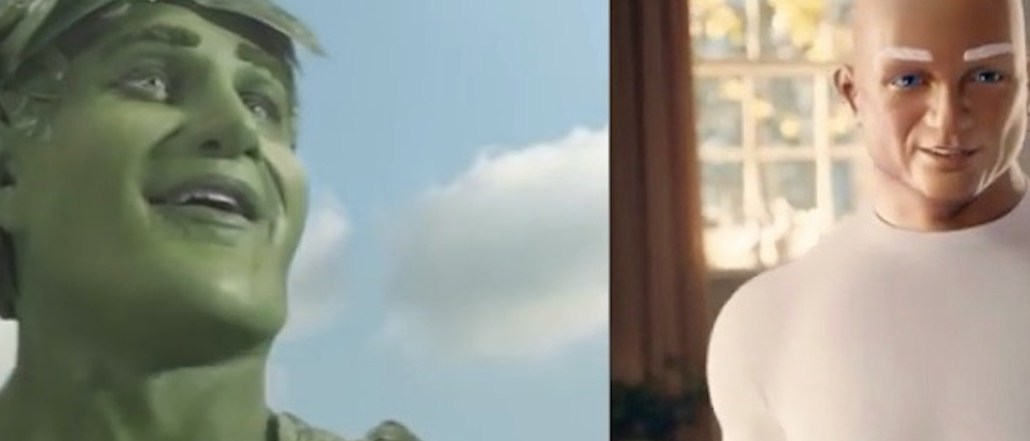
Mark Duffy has written the Copyranter blog for 11 years and is a freelancing copywriter with 25-plus years of experience. His hockey wrist shot is better than yours.
In early January, B&G Foods and ad agency Deutsch reanimated the monstrous “Green Giant” (he’s no longer officially “Jolly”).
This Sunday, Procter & Gamble will officially introduce a creepy CGI version of Mr. Clean to the world during the Super Bowl.
KFC brought back the dead “Colonel” (who was mighty creepy) and keeps bringing him back with different actors/comedians. Except none of them have been very funny (seemingly on purpose), so they come off as unsettling. Actor Billy Zane is the latest scary Colonel, made of gold.
Pressing question: Why bring back old, tired, disturbing mascots?
The obvious answer: It’s easier than coming up with a new campaign concept. Plus, brands love-love-love their own “storied” histories.
If you look at the history of the Green Giant, you see so many creepy creations, each version scarier than the last. Here are a few examples:
This was one of his first TV appearances. Look at that face. He looks like he wants to pick up that silo, smash the farmhouse, grab any fleeing humans, and eat them with oversized peas and corn. He was just as frightening in print:

That version of him at left would make a perfectly horrifying movie monster. See more of his frightening ads through the years here.
And now he’s back. Except he’s a real person, a Lithuanian cage fighter who also works as a lawyer in London, according to Campaign.
https://www.youtube.com/watch?v=U34j2sABPFQ
To try to convince us that he isn’t a flesh-eating monster, they show a woman swooning for him, imagining what he’s got working underneath that leafy tog. Here’s a second spot where he crushes a man while making a snow angel.
Mr. Clean (known as Mr. Proper in the rest of the world) isn’t as old as the Green Giant, but he is monochromatic right down to his eyebrows. He certainly waxes his body. Maybe even bleaches … never mind. He made his TV debut as a crude animated character in the late 1950s. Then in early 1960s, actor House Peters, Jr. started playing him, wearing a suit, which made him look like a white-collar serial killer:
Last year, P&G showed us the origin of Mr. Clean, a big-headed orphan.
 Now he’s back as a very ripped, animated man who “does it all over the house,” according to Leo Burnett Toronto’s press note. He appears to be spray-painted white while wearing only white shoes and a white codpiece.
Now he’s back as a very ripped, animated man who “does it all over the house,” according to Leo Burnett Toronto’s press note. He appears to be spray-painted white while wearing only white shoes and a white codpiece.
https://www.youtube.com/watch?v=GDzMxlw2Fgo
Again, to put us off his weirdness, the woman wants to get nasty-dirty with him because “you gotta love a man who cleans.” Bravo, P&G, the spot is doubly sexist.

P&G does plan on switching to a real-life Mr. Clean later this year — an African-American from Georgia named Mike Jackson. Get prepared for the hate mail, David Taylor.
Lastly, the most disturbing current brand mascot of them all, Snuggle, is now available for you t0 (horrify) “serenade” your significant other for Valentine’s Day. Somebody get a flamethrower.
https://www.youtube.com/watch?v=mgPWgfdNNEM
More in Marketing

WTF is the CMA — the Competition and Markets Authority
Why does the CMA’s opinion on Google’s Privacy Sandbox matter so much? Stick around to uncover why.

Marketing Briefing: How the ‘proliferation of boycotting’ has marketers working understand the real harm of brand blockades
While the reasons for the boycotts vary, there’s a recognition among marketers now that a brand boycott could happen regardless of their efforts – and for reasons outside of marketing and advertising – that will need to be dealt with.

Temu’s ad blitz exposes DTC turmoil: decoding the turbulent terrain
DTC marketers are pointing fingers at Temu, attributing the sharp surge in advertising costs across Meta’s ad platforms to its ad dollars.








